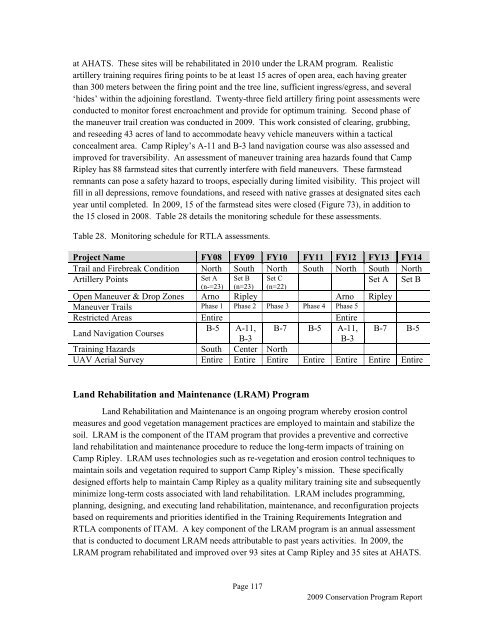camp ripley and arden hills minnesota army national guard training ...
camp ripley and arden hills minnesota army national guard training ...
camp ripley and arden hills minnesota army national guard training ...
Create successful ePaper yourself
Turn your PDF publications into a flip-book with our unique Google optimized e-Paper software.
at AHATS. These sites will be rehabilitated in 2010 under the LRAM program. Realistic<br />
artillery <strong>training</strong> requires firing points to be at least 15 acres of open area, each having greater<br />
than 300 meters between the firing point <strong>and</strong> the tree line, sufficient ingress/egress, <strong>and</strong> several<br />
„hides‟ within the adjoining forestl<strong>and</strong>. Twenty-three field artillery firing point assessments were<br />
conducted to monitor forest encroachment <strong>and</strong> provide for optimum <strong>training</strong>. Second phase of<br />
the maneuver trail creation was conducted in 2009. This work consisted of clearing, grubbing,<br />
<strong>and</strong> reseeding 43 acres of l<strong>and</strong> to accommodate heavy vehicle maneuvers within a tactical<br />
concealment area. Camp Ripley‟s A-11 <strong>and</strong> B-3 l<strong>and</strong> navigation course was also assessed <strong>and</strong><br />
improved for traversibility. An assessment of maneuver <strong>training</strong> area hazards found that Camp<br />
Ripley has 88 farmstead sites that currently interfere with field maneuvers. These farmstead<br />
remnants can pose a safety hazard to troops, especially during limited visibility. This project will<br />
fill in all depressions, remove foundations, <strong>and</strong> reseed with native grasses at designated sites each<br />
year until completed. In 2009, 15 of the farmstead sites were closed (Figure 73), in addition to<br />
the 15 closed in 2008. Table 28 details the monitoring schedule for these assessments.<br />
Table 28. Monitoring schedule for RTLA assessments.<br />
Project Name<br />
FY08 FY09 FY10 FY11 FY12 FY13 FY14<br />
Trail <strong>and</strong> Firebreak Condition North South North South North South North<br />
Artillery Points<br />
Set A Set B<br />
Set A<br />
(n-=23)<br />
Set B<br />
(n=23)<br />
Page 117<br />
Set C<br />
(n=22)<br />
Open Maneuver & Drop Zones Arno Ripley Arno Ripley<br />
Maneuver Trails Phase 1 Phase 2 Phase 3 Phase 4 Phase 5<br />
Restricted Areas Entire Entire<br />
L<strong>and</strong> Navigation Courses<br />
B-5 A-11,<br />
B-3<br />
B-7 B-5 A-11,<br />
B-3<br />
B-7 B-5<br />
Training Hazards South Center North<br />
UAV Aerial Survey Entire Entire Entire Entire Entire Entire Entire<br />
L<strong>and</strong> Rehabilitation <strong>and</strong> Maintenance (LRAM) Program<br />
L<strong>and</strong> Rehabilitation <strong>and</strong> Maintenance is an ongoing program whereby erosion control<br />
measures <strong>and</strong> good vegetation management practices are employed to maintain <strong>and</strong> stabilize the<br />
soil. LRAM is the component of the ITAM program that provides a preventive <strong>and</strong> corrective<br />
l<strong>and</strong> rehabilitation <strong>and</strong> maintenance procedure to reduce the long-term impacts of <strong>training</strong> on<br />
Camp Ripley. LRAM uses technologies such as re-vegetation <strong>and</strong> erosion control techniques to<br />
maintain soils <strong>and</strong> vegetation required to support Camp Ripley‟s mission. These specifically<br />
designed efforts help to maintain Camp Ripley as a quality military <strong>training</strong> site <strong>and</strong> subsequently<br />
minimize long-term costs associated with l<strong>and</strong> rehabilitation. LRAM includes programming,<br />
planning, designing, <strong>and</strong> executing l<strong>and</strong> rehabilitation, maintenance, <strong>and</strong> reconfiguration projects<br />
based on requirements <strong>and</strong> priorities identified in the Training Requirements Integration <strong>and</strong><br />
RTLA components of ITAM. A key component of the LRAM program is an annual assessment<br />
that is conducted to document LRAM needs attributable to past years activities. In 2009, the<br />
LRAM program rehabilitated <strong>and</strong> improved over 93 sites at Camp Ripley <strong>and</strong> 35 sites at AHATS.<br />
2009 Conservation Program Report
















